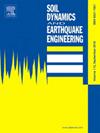Nonlinear adaptive control of flexibly-supported inelastic asymmetric steel structures equipped with MR dampers
IF 4.2
2区 工程技术
Q1 ENGINEERING, GEOLOGICAL
引用次数: 0
Abstract
Despite previous studies, this paper simultaneously addresses the challenges of soil-structure interaction (SSI) and nonlinear structural behavior in torsionally irregular building structures equipped with magnetorheological (MR) dampers, utilizing a supervisory nonlinear adaptive control procedure. This represents a significant step toward improving the design of earthquake-resisting structures. In order to consider the effects of torsional behavior on the performance of semi-active MR control systems, various inelastic asymmetric steel structures with different periods, eccentricities, and torsional-to-translational frequency ratios based on supports with different levels of flexibility were used. In these structures, the steel elements were modeled by the extended plasticity (fiber) while the support flexibility effects were accounted for based on the substructure method in OpenSees software. A new model-based nonlinear adaptive control algorithm was employed to control a wide range of structures subjected to various seismic records in bi-directional excitation, incorporating the effects of support flexibility. Results show that the MR dampers reduce the Engineering Demand Parameters (EDPs) significantly, considering the effects of the soft and stiff edges of the structure in various scenarios. Analysis of the effects of the support flexibility on the MR damper performance demonstrated the successful function of the damper in improving the seismic performance of such structures.
求助全文
约1分钟内获得全文
求助全文
来源期刊

Soil Dynamics and Earthquake Engineering
工程技术-地球科学综合
CiteScore
7.50
自引率
15.00%
发文量
446
审稿时长
8 months
期刊介绍:
The journal aims to encourage and enhance the role of mechanics and other disciplines as they relate to earthquake engineering by providing opportunities for the publication of the work of applied mathematicians, engineers and other applied scientists involved in solving problems closely related to the field of earthquake engineering and geotechnical earthquake engineering.
Emphasis is placed on new concepts and techniques, but case histories will also be published if they enhance the presentation and understanding of new technical concepts.
 求助内容:
求助内容: 应助结果提醒方式:
应助结果提醒方式:


